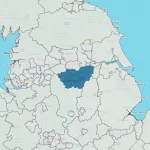Churches to Help Spread Wireless Broadband into Rural England
The UK Government has reached a new accord with the National Church Institutions (NCIs) of the Church of England, which should make it easier for churches to be used in order to help distribute faster wireless broadband and WiFi services across rural communities.
Churches tend to be one of the highest structures in rural communities and as such their towers (or spires) can be very useful when adopted to act as a distribution point for a local Fixed Wireless Access (FWA), Mobile Broadband or WiFi network. The idea of using churches in this way is of course nothing new and some ISPs, such as WiSpire in Norfolk (they’ve partnered with the Dioceses of Norwich), have been doing it for a long time.
Last year the UK government signalled that they were keen to work with the Church of England (here) in order to encourage support for similar deployments across other parts of the country (there are about 16,000 churches across the whole of England) and today’s accord would appear to be the result. There is also the possibility that similar accords could be made with other faith communities that have similar estates.
Advertisement
Crucially the new guidance will ensure that any telecoms infrastructure deployed does not impact on the character and architectural or historic significance of churches. The Government has also pledged to provide advice for parishes and dioceses to enable them to “consider supporting digital connectivity and to develop the necessary skills for digital infrastructure projects“.
Matt Hancock MP, DCMS Secretary of State, said:
“Churches are central features and valued assets for local communities up and down the country. This agreement with the Church of England will mean that even a 15th century building can help make Britain fit for the future improving people’s lives by boosting connectivity in some of our hardest-to-reach areas.”
Rt Revd Stephen Cottrell, Bishop of Chelmsford, said:
“We know that rural churches in particular have always served as a hub for their communities. Encouraging churches to improve connectivity will help tackle two of the biggest issues rural areas face – isolation and sustainability.
The Diocese of Chelmsford has been pioneering this approach with County Broadband since 2013. Our work has significantly improved rural access to high-speed broadband.
Many new forms of technology are available to improve internet access in rural areas and I hope that this partnership between the Church of England and the Government will help rural churches consider how they can be part of the solution.
I know that many churches already help people access the internet and provide digital skills training, and this Accord is a natural extension of great work already occurring.”
We should point out that the accord itself covers “all types of mobile and broadband technologies” and churches will be free to explore different options to meet the needs of their communities. Wireless networks are the ones most likely to benefit, although the government suggests that Satellite and more traditional fibre optic cables could also have a role to play (they probably mean fibre fed wireless).
The news is good, although we suspect that it won’t make a huge difference to the overall deployment picture. Generally churches have rarely ever been considered a big obstacle to the rollout of new broadband networks. Indeed there are already more than 120 cases of broadband and mobile services being delivered from parish churches across the country. Getting the capacity to the church in the first place is also an issue.
Nevertheless this is a useful improvement and clarification for ISPs. Related guidance on the installation of telecoms equipment in churches can be found HERE and HERE. Now let’s take a moment to pray for better rural broadband.
Advertisement
Mark is a professional technology writer, IT consultant and computer engineer from Dorset (England), he also founded ISPreview in 1999 and enjoys analysing the latest telecoms and broadband developments. Find me on X (Twitter), Mastodon, Facebook, BlueSky, Threads.net and Linkedin.
« ISP Dyfed Superfast Brings Wireless Broadband to Yscir in Wales

















































Comments are closed